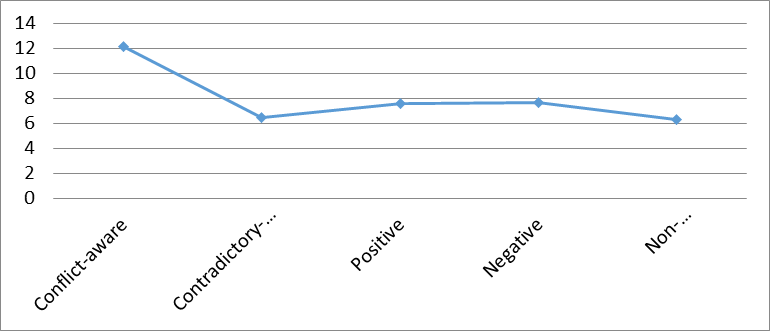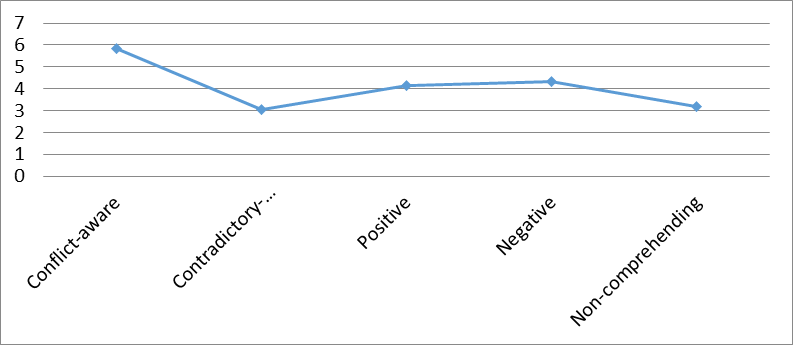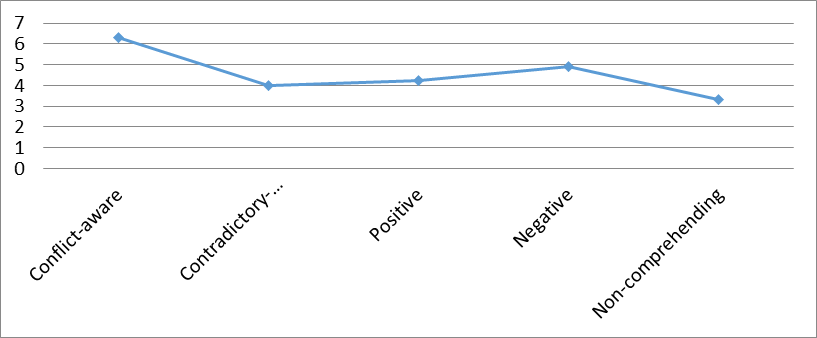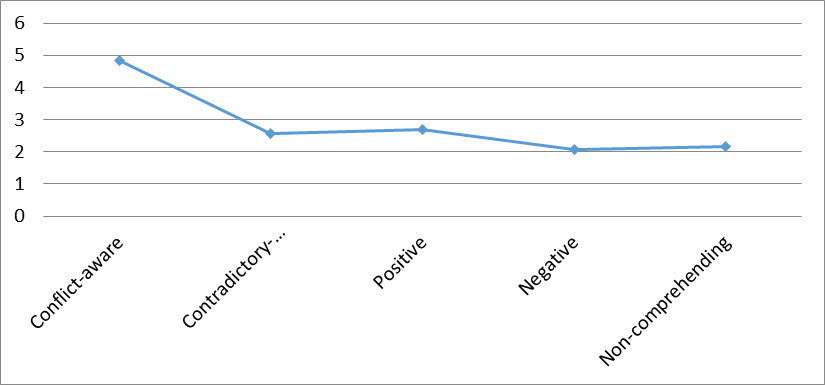Abstract
The article examines the relevance of studying the student’s self-reflection, proposes a projective method of studying the meanings of “I” based on the self-esteem indirect assessment technique (SIAT, rus. KISS), and presents the result of the research on primary-year students based on the abovementioned method. 5 types of self-reflection are identified: “Non-comprehending”, “Positive”, “Negative”, “Contradictory-denotative”, “Conflict-aware”. Thus, the results of SIAT(m) method demonstrates a paradoxical tendency for the level of positive self-concept and self-esteem to increase in subjects with contradictory, conflicting meanings of “I”. Within the framework of theoretical constructions, the following explanation can be given. The appearance of the contradictions of the meanings of “I” in self-consciousness poses a threat to the feeling of “I am good” and activates defense mechanisms that trigger the transformation mechanism of a self-image. Positive meanings are more actively reflected in a person's self-consciousness, which is accompanied by an increase in positive self-concept and self-esteem. On the other hand, we can assume that the presence of contradictions and conflicting meanings is characteristic of subjects with a higher level of self-awareness that allows the statement “I am bad”. They are inherently characterized by a more positive self-concept and higher self-esteem, which allows them to recognize the presence of contradictions in their personality.
Keywords: Meanings of "I", self-assessment, self-awareness, self-esteem, self-esteem indirect assessment technique, students
Introduction
The problem of the student's entry into the educational environment of the university is considered in psychological science from different sides, the influence of both external factors, such as socio-demographic (Elffers & Oort, 2013; Rothon et al., 2011), and internal, such as self-esteem, state control, identity, is studied (Burger & Naudé, 2019; Simonsen & Rundmo, 2020; Stupnisky et al., 2007; Workman & Heyder, 2020).The modern educational environment of a university makes high demands on the development of students' self-awareness and their ability to comprehend themselves in learning and future professional activities. This is supported by the following provisions.
The process of study at the university is accompanied by the process of social and psychological adaptation, during which the student enters a new social environment, learns new social roles and experiences the formation of new aspects of his/her identity. “Higher professional institution imposes requirements on modern students for independent and extremely dynamic mastering of new competences, new forms and ways of their development and self-development, new ways of social interactions” (Grigoryeva et al., 2017, p. 24).
The problem of students dropping out during the first years of study is typical not only for Russia, but also for countries in Europe and North America (Elffers et al., 2013; Haugan et al., 2019).
One of the factors of successful course of these processes is the developed self-consciousness and self-perception: “Reflection helps students to reflect and assimilate the acquired knowledge, formulate values, evaluate results, determine goals for further work, and adjust their educational path” (Grigoryeva et al., 2017, p. 24).
“A prerequisite for the rapid adaptation of the freshman to the university is his/her ability to constantly and intensively improve, to update and develop his/her own abilities and qualities, which implies the ability to be aware of his/her own emotional resources” (Aleksandrovich, 2015, p. 82).
A recognized effective means to ensure successful psychological adaptation in college age is reflection, which enables the individual to trace, analyze, and resolve the contradiction between the environment and the individual. Reflexivity provides harmony of relations in the system “I”– society” through balancing social and individual values, meanings, needs in the system “I”– academic requirements” through optimizing the use of personal resources (Golubeva, 2018).
In case of successful adaptation to learning, the student moves to the stage of conscious improvement of the results of his/her studies (Aleksandrovich, 2015).
It is also important that modern education and working life in many spheres take place in a dynamic social environment characterized by the rapidly changing job requirements, emergence of new fields, the need for regular further training or even a change of specialty. From our point of view, social adaptation in these conditions will be more successful in case of developed ability to comprehend oneself in the context of learning and professional activity.
It is also necessary to take into account the fact that the beginning of higher education falls on the period of senior adolescence, when a person's self-consciousness undergoes qualitative changes in the context of building a personality's own hierarchy of motives and system of values, formation of an individual life plan, self-determination and formation of worldview, that is, formation and development of human “I” meanings (Gutkina, 2018; Kulagina & Apasova, 2018; Slobodchikov & Cukerman, 1996). Therefore, studying at the university does not only involve mastering professional competences, but also comprehending studies and the profession as a means of constructing one's own life path and comprehending oneself in educational and professional activities.
These conditions apply to students in technical, natural science and humanities, i.e. they are universal.
Problem Statement
The process of giving meaning to oneself has already been investigated by V. V. Stolin, who defined the notion of “meaning of I” as an attitude toward a motive or goal of the subject's qualities relevant to their attainment, which are formalized in self-consciousness in meanings (the cognitive aspect) and emotional experiences (the emotional aspect).
A review of the scientific literature has shown that for 30 years this topic has been hardly developed at all in Russian psychological science, especially in terms of studying the cognitive aspect of the meaning of “I”. Single developments can be found in works devoted to reflection (Shchebetenko, 2015), but in general, psychological science does not have a comprehensive toolkit for studying the meaning of “I”, no material has been accumulated about its structure and characteristics, there is no empirical data on its features and meaning in adolescence, development of the student's personality and his/her adaptation to the educational environment.
In foreign psychology, only particular aspects of this topic have been addressed, such as students' reflection of their qualities in terms of future employment (Räty et al., 2019) or the relationship of meaning constructions and self-image in children (Komatsu, 2019).
Research Questions
What are the psychological indicators of a person's meanings of “I” and their individual differences?
What techniques are needed to study them?
What is the typology of students' meanings of “I” (students' self-understanding)?
Purpose of the Study
To formulate indicators of such a psychological characteristic as the meaning of “I”, and to test the methodology for its study, created on the basis of the projective methodology for self-esteem indirect assessment developed by E. O. Fedotova (as cited in 1982). To carry out the test on a sample of 1–2 year students, after which, on the basis of the respondents' answers, propose a typology of how students understand themselves.
Research Methods
On the basis of theoretical analysis, the following indicators of the meaning of “I” were identified:
- a reflection in the psyche of the connection of one's traits with motives, values;
- division by importance of one's own features, formation of a hierarchy of one's own personality traits;
- emotional indication of one's traits, on the basis of which the self-perception of a personality is formed.
It can also be assumed that self-perception and the hierarchization of one's traits are reflected in the personality's self-esteem system in a complex way.
A methodological technique that reduces the difficulty of studying self-awareness is a combination of self-reports and projective techniques. In order to study the meanings of “I”, it is necessary to develop a battery of methods, at one pole of which will be verbal self-reports, and at the other pole - projective techniques. Based on the provisions outlined above, a methodological complex, including self-reports and projective techniques, was developed to study the meanings of “I”.
1) Structured survey – self-report.
2) A modification of the Sentence Completion Test (Sachs & Levy, 1950) (“Sentences”), a verbal projective technique.
3) Modification of the method “Self-esteem indirect assessment technique” (Sokolova & Fedotova, 1982) or SIAT(m) (КИСС(m)) – non-verbal projective technique.
To study the connection between the cognitive and emotional aspects of the meaning of “I”, the developed methods were supplemented with the Stolin-Pantileev Self-Ratio Questionnaire.
The modification (hereinafter referred to as SIAT (m)), as in the original methodology, used a set of ten facial drawings, but the number of tasks was expanded. To the ranking of faces in terms of attractiveness and resemblance to the subject, a ranking on the following parameters was added:
- openness, sociability – reticence;
- attachment to people - detachment;
- self-control – impulsiveness;
- emotional stability – emotional instability;
- practicality – dreaminess;
- academic success – academic failure;
- success in communication – failure in communication;
- success in the profession – failure in the profession;
- success in interpersonal relationships – failure in interpersonal relationships.
The first five parameters, as in the methods described above, were identified on the basis of the Big Five (Goldberg, 1990; Knyazev et al., 2010). The parameters of success, in turn, cover the most significant areas of personal life activity in adolescence.
After completing the ranking, subjects describe their character traits by scaling scores based on the Big Five on a 5-point scale – similar to the structured interviewing technique described above (In this study, the responses from the first technique were used to reduce time costs).
Then the rank correlation coefficients between the ranking parameters of individuals are calculated. A total of 38 coefficients can be obtained by using this technique. Then, based on the coefficients obtained the personality traits that have “significance” and “meaning” for the examinees are highlighted. They are highlighted according to the following scheme.
If the correlation of a trait with success in any area exceeds 0.5, then the trait is considered to have “positive significance for success” from the examinee's point of view. If the coefficient is less than - 0.5, then it is “negative significance for success”. It is assumed that if a trait (e.g., extraversion) has a “negative significance for success”, then it’s opposite (e.g., introversion) takes on a “positive significance for success”. And vice versa.
When coefficients greater than 0.5 and less than -0.5 are simultaneously observed for one trait (for success in different areas), it is considered to have a “conflicting significance for success”.
Then a correlation with the subjects' scale self-descriptions is made. As indicated above, subjects rated their expression of each of the five traits on a five-point scale. Scores 1, 2 are considered to indicate one pole of the trait (e.g., “extraversion”), 4, 5 the opposite (e.g., “introversion”), and score 3 is excluded from the analysis. If a subject picked out one of the trait poles (scoring 1, 2, 4, or 5) and simultaneously assigned it a “positive significance for success”, the trait was viewed as having “positive significance to him or her”. The traits with “negative” and “conflict” significance were distinguished according to the same principle.
Then the significance of the areas is assessed, success in which according to the technique attaches a positive, negative or conflict significance to the trait. For this purpose, the correlations of the success scales and the “Like” scale are considered. If the correlation value exceeds 0.5, success in the relevant area is considered to be personally significant for the examinee. In this case, the negative, positive or conflict significance of the trait was already seen as a negative, positive or conflict meaning.
Thus, each of the five traits can acquire positive, negative, and conflicting significances and senses for the subject. Based on the data for all five traits, a profile of “significances and meanings of I” is constructed (Tables 01,02,03).
In order to assess the connection between the meanings of “I” and the system of self-assessment and self-concept of the individual, the results of the developed techniques were compared with the indicators of the SRQ (Self-Ratio Questionnaire) and the following indicators of the SIAT (m) technique:
- general self-esteem (correlation of “Like” and “Similar to me” choices);
- assessment of one's success in learning (correlation of “Similar to me” and “Successful in learning” choices);
- assessment of one's success in communication (correlation of the choices “Similar to me” and “Successful in communication”);
- assessment of one's success in the future profession (correlation of “Similar to me” and “Successful in the profession” choices);
- assessment of one's success in interpersonal relations (correlation of the choices “Similar to me” and “Successful in interpersonal relations”).
Findings
The data were collected on a sample of 1st and 2nd year students of Novgorod State University from different specialties. The total sample size is 72 people. In order to optimize data collection, a computerized version of the technique was developed using Microsoft Excel.
After testing, a profile of the “significances and meanings of I” was constructed for each subject using the SIAT(m) technique, according to which the subjects were divided into the following types:
1) “Non-comprehending”– subjects whose profile lacks significances and meanings.
2) “Positive”– only positive significances and meanings of personality traits are present in the profiles.
3) “Negative”– the profile contains only negative significances and meanings of personality traits.
4) “Contradictory-denotative”– consists of subjects from two groups. The first is the subjects whose profile contains positive (for some traits) and negative (for other traits) significances and no trait meanings. The second are subjects whose profile contains conflicting significances and no meanings. A common characteristic of this type is the presence of contradiction in endowing their features with significances and the absence of endowing the features with meanings.
5) “Conflict-aware”– subjects with different profiles were also included in this type. The first group consisted of subjects in whose profile conflicting meanings were observed. The second group consists of subjects whose profile contains positive meanings for some personality traits and negative meanings and significances for other traits. A common characteristic of this type is the presence of a contradiction in self-comprehension.
The distribution of these types in the sample is presented in Table 04.
The levels of self-esteem and self-concept of the highlighted types were compared using a single-factor analysis of variance. Statistically significant level changes were found for the following indicators:
- general self-concept (F= 3.3, p<0.05; Figure 01);
- self-respect (F= 3.11, p<0.05; Figure 02);
- self-confidence (F= 3.45, p<0.05; Figure 03);
- self-acceptance (F= 2.68, p<0.05; Figure 04);
- self-understanding (F= 4.13, p<0.01; Figure 05).





Analysis of the distribution of mean values in the highlighted types showed a significant difference between the “Conflict-aware” type and the others. For a more detailed study of this type, its indicators were compared with those of the rest of the sample. The comparison was done using Mann–Whitney U-test (Table 05).
A difference of the “conflict-comprehending” type was found in most indicators of self-esteem and self-perception (except for the indicators “Assessment of one's success in interpersonal relations”, “Self-interest”). The “conflict-comprehending” respondents generally have higher self-esteem and a more positive self-concept.
Conclusion
Thus, the results of SIAT(m) method demonstrates a paradoxical tendency for the level of positive self-concept and self-esteem to increase in subjects with contradictory, conflicting meanings of “I”. Within the framework of theoretical constructions, the following explanation can be given.
The appearance of the contradictions of the meanings of “I” in self-consciousness poses a threat to the feeling of “I am good” and activates defense mechanisms that trigger the transformation mechanism of a self-image. Positive meanings are more actively reflected in a person's self-consciousness, which is accompanied by an increase in positive self-concept and self-esteem. It is the situation of combination, threat of negative meanings in relation to positive ones is important, because in subjects of “negative” type the increase of positive self-esteem and self-assessments is not observed.
On the other hand, we can assume that the presence of contradictions and conflicting meanings is characteristic of subjects with a higher level of self-awareness that allows the statement “I am bad”. They are inherently characterized by a more positive self-concept and higher self-esteem, which allows them to recognize the presence of contradictions in their personality. Awareness of these contradictions does not activate their psychological defense, but triggers the activity of self-consciousness, the study of one's own personality. This assumption is confirmed by the low frequency of occurrence of this type of self-perception in the sample.
Acknowledgments
I express gratitude to my research supervisor Tatyana Viktorovna Arkhireeva and my colleague Anna Arkadyevna Moiseeva for the help in carrying out the research.
References
Aleksandrovich, P. I. (2015). Psihologicheskaya adaptaciya studentov k obucheniyu v vysshem uchebnom zavedenii [Psychological Adaptation of Students to Higher Education]. Trudy BGTU. Seriya 6: Istoriya, filosofiya [Proceedings of BSTU. Series 6: History, Philosophy], 5(178), 80-84.
Burger, A., & Naudé, L. (2019). Predictors of academic success in the entry and integration stages of students’ academic careers. Social Psychology of Education, 22(3), 743-755.
Elffers, L., & Oort, F. J. (2013). Great expectations: students’ educational attitudes upon the transition to post-secondary vocational education. Social Psychology of Education, 16, 1-22.
Goldberg, L. R. (1990). An alternative “Description of personality”: The Big-Five factor structure. Journal of Personality and Social Psychology, 59, 1216-1229.
Golubeva, N. M. (2018). Osobennosti refleksii v psihologicheskoj adaptacii studentov k obrazovatel'noj srede organizacii vysshego obrazovaniya [Peculiarities of reflexion in psychological adaptation of students to the educational environment of higher education institution]. (Doctoral dissertation). https://www.dissercat.com/content/osobennosti-refleksii-v-psikhologicheskoi-adaptatsii-studentov-k-obrazovatelnoi-srede-organi
Grigoryeva, M. V., Shimionov, R. V., & Golubeva, N. M. (2017). Rol' refleksii v adaptacionnom processe studentov k usloviyam obucheniya v vuze [Role of self-reflection in the process of student adaptation to university]. Psikhologicheskaya nauka i obrazovaniye [Psychological Science and Education], 22(5), 23-30.
Gutkina, N. I. (2018). Koncepciya L. I. Bozhovich o stroenii i formirovanii lichnosti (kulturno-istoricheskij podhod). [L. I. Bozhovich's Concept of Personality Structure and Formaition (Cultural-Historical Approach)]. Kulturno-istoricheskaya psihologiya [Cultural-Historical Psychology], 14(2), 116-128.
Haugan, J. A., Frostad, P., & Mjaavatn, P. (2019). A longitudinal study of factors predicting students’ intentions to leave upper secondary school in Norway. Social Psychology of Education, 22, 1259-1279.
Knyazev, G. G., Mitrofanova, L. G., & Bocharov, V. A. (2010). Validizaciya russkoyazychnoj versii oprosnika L. Goldberga “Markery faktorov “Bol'shoj pyaterki” [Validization of russian version of Goldberg's “big-five factor markers” inventory]. Psihologicheskij zhurnal [Journal of Psychology], 31(5), 100-110.
Komatsu, K. (2019). Meaning-Making for Living: The Emergence of the Presentational Self in Children’s Everyday Dialogues. Springer.
Kulagina, I. Yu., & Apasova, E. V. (2018). Razvitie lichnosti pri obuchenii v vuze (sravnitel'noe issledovanie) [Personality development in the context of university training: a comparative study]. Kulturno-istoricheskaya psihologiya [Cultural-Historical Psychology], 14(2), 12-23.
Räty, H., Kasanen, K., Siivonen, P., Komulainen, K., Kozlinska, I., & Hytti, U. (2019). Being stable and getting along with others: perceived ability expectations and employability among Finnish university students. Social Psychology of Education, 22(4), 757-773.
Rothon, C., Arephin, M., Klineberg, E., Cattell, V., & Stansfeld, S. (2011). Structural and socio-psychological influences on adolescents’ educational aspirations and subsequent academic achievement. Social Psychology of Education, 14(2), 209-231.
Sachs, J. M., & Levy, S. (1950). The sentence completion test. In L. Bellak (Ed.), Projective psychology (pp. 357-397). Knopf.
Shchebetenko, S. A. (2015). Refleksivnye adaptacii haraktera v pyati faktornoj teorii lichnosti [Reflexive characteristic adaptations within the five-factor theory of personality framework]. Psihologicheskij zhurnal [Journal of Psychology], 36(6), 55-65.
Shmeleva, E., & Semenova, T. (2020). The role of school identification and self-efficacy in school satisfaction among Norwegian high-school students. Social Psychology of Education, 23(6), 1565-1586.
Slobodchikov, V. I., & Cukerman, G. A. (1996.) Integralnaya periodizaciya obshchego psihicheskogo razvitiya [Integral periodization of general mental development]. Voprosy psihologii [Psychology Issues], 5, 38-50.
Sokolova, E. T., & Fedotova, E. O. (1982) Aprobaciya metodiki kosvennogo izmereniya sistemy samoocenok (KISS). [Approbation of the self-esteem indirect assessment technique, SIAT]. Vestnik Moskovskogo universiteta [Bulletin of Moscow University], 3, 77-81.
Stupnisky, R. H., Renaud, R. D., Perry, R. P., Ruthig, J. C., Haynes, T. L., & Clifton, R. A. (2007). Comparing self-esteem and perceived control as predictors of first-year college students’ academic achievement. Social Psychology of Education, 10, 303-330.
Workman, J., & Heyder, A. (2020) Gender achievement gaps: the role of social costs to trying hard in high school. Social Psychology of Education, 23(6), 1407-1427.
Copyright information

This work is licensed under a Creative Commons Attribution-NonCommercial-NoDerivatives 4.0 International License.
About this article
Publication Date
15 July 2021
Article Doi
eBook ISBN
978-1-80296-113-3
Publisher
European Publisher
Volume
114
Print ISBN (optional)
-
Edition Number
1st Edition
Pages
1-778
Subjects
Globalization, digital education, leadership, challenges of the time, оn-line pedagogy, universal and national values
Cite this article as:
Novikov, A. (2021). Studying The Individual Differences In The Meanings Of The “I” Of Students. In A. G. Shirin, M. V. Zvyaglova, O. A. Fikhtner, E. Y. Ignateva, & N. A. Shaydorova (Eds.), Education in a Changing World: Global Challenges and National Priorities, vol 114. European Proceedings of Social and Behavioural Sciences (pp. 677-687). European Publisher. https://doi.org/10.15405/epsbs.2021.07.02.81

